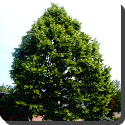 Basswood American — Tilia americana is a species of Tilia, native to eastern North America, from southeast Manitoba east to New Brunswick, southwest to northeast Texas, and southeast to South Carolina, and west along the Niobrara River to Cherry County, Nebraska. Common names include Basswood (also applied to other species of Tilia in the timber trade) and American Linden or the Lime-Tree.
Basswood American — Tilia americana is a species of Tilia, native to eastern North America, from southeast Manitoba east to New Brunswick, southwest to northeast Texas, and southeast to South Carolina, and west along the Niobrara River to Cherry County, Nebraska. Common names include Basswood (also applied to other species of Tilia in the timber trade) and American Linden or the Lime-Tree.
It is a medium-sized to large deciduous tree reaching a height of 20-40 m (exceptionally 43 m) with a trunk diameter of 1-1.3 m at maturity. The crown is domed, the branches spreading, often pendulous. The bark is gray to light brown, with narrow, well defined fissures. The roots are large, deep, and spreading. The twigs are smooth, reddish-green, becoming light gray in their second year, finally dark brown or brownish gray, marked with dark wart-like excrescences. The winter buds are stout, ovate-acute, smooth, deep red, with two bud scales visible. The leaves are simple, alternately arranged, ovate to cordate, inequalateral at the base (the side nearest the branch the largest), 10-15 cm (exceptionally 25 cm) long and broad, with a long, slender petiole, a coarsely serrated margin and an acuminate apex. They open from the bud conduplicate, pale green, downy; when full grown are dark green, smooth, shining above, paler beneath, with tufts of rusty brown hairs in the axils of the primary veins; the small stipules fall soon after leaf opening. The fall color is yellow-green to yellow. Both the twigs and leaves contain mucilaginous sap. The flowers are small, fragrant, yellowish-white, 10–14 mm diameter, arranged in drooping, cymose clusters of 6–20 with a whitish-green leaf-like bract attached for half its length at the base of the cyme; they are perfect, regular, with five sepals and petals, numerous stamens, and a five-celled superior ovary. Flowering is in early to mid summer; pollination is by bees. The fruit is a small, globose, downy, hard and dry cream-colored nutlet with a diameter of 8-10 mm.
The wood is pale brown, sometimes nearly white or faintly tinged with red; light, soft with fine close grain; clear of knots but does not split easily. It is sold generally under the name basswood, but is sometimes confounded with tulip-wood and then called white-wood, and is largely used in the manufacture of wooden-ware, wagon boxes and furniture. It has a density of 0.4525. This makes it valuable in the manufacture of wooden-ware, cheap furniture, bodies of carriages; it is also especial.
 Kids Portal For Parents India Kids Network
Kids Portal For Parents India Kids Network






